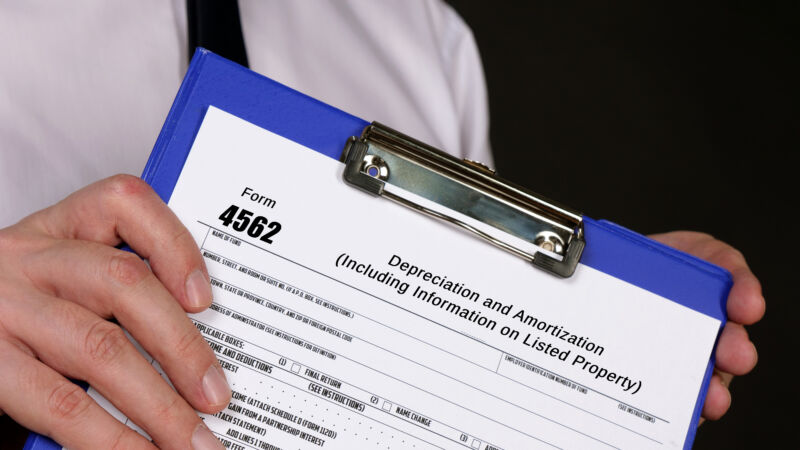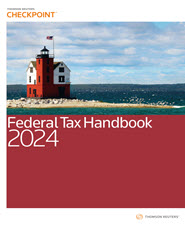How to claim deductions for tangible and intangible assets.
Jump to:
| What is Form 4562? |
| Form 4562 instructions |
| Is Form 4562 required every year? |
| What is listed property for depreciation? |
| What does a depreciation schedule look like? |
| Section 179 and expensing property |
Running a company is expensive. Therefore, helping business clients save money and reduce their tax burden by expensing property they’ve purchased for their company and claiming deductions for depreciation or amortization of assets is critical.
If, during the tax year, a client has purchased a tangible or intangible asset and is looking to claim depreciation and amortization deductions or expense certain property under Section 179, Form 4562 must be filed with their annual tax return. Let’s take a closer look at the form and its uses.
What is Form 4562?
As the name suggests, Form 4562: Depreciation and Amortization is an IRS form that business taxpayers use to claim deductions for depreciation and amortization of tangible or intangible assets. However, Form 4562 also has additional uses. It is used to expense certain property under Section 179, and to provide information on the business or investment use of vehicles and other property.
Form 4562 instructions
When completing Form 4562: Depreciation and Amortization there are six parts to be aware of:
Part I: Election To Expense Certain Property Under Section 179
If a business client has made a purchase of equipment and other eligible property during the tax year and they would like to immediately write-off a portion, if not all, of the expense (versus recover the cost of the asset over a number of years) then Part I of Form 4562 must be completed.
Section 179 is an immediate expense deduction that allows taxpayers to deduct a set dollar amount. For tax years beginning in 2023, the maximum expense deduction allowed under Section 179 is $1,160,000 (up from $1,080,000 in 2022).
As explained by the IRS, this limit is reduced by the amount by which the cost of section 179 property placed in service during the tax year exceeds $2,890,000. Also, the maximum section 179 expense deduction for sport utility vehicles placed in service in tax years beginning in 2023 is $28,900 (up from $27,000 in 2022).
Section 179 deductions are limited to annual taxable business income. In other words, a business cannot deduct more money than it made.
Part II: Special Depreciation Allowance
If a business client wants to write off a large percentage of an eligible asset’s cost in the first year it was purchased and take advantage of an additional special depreciation allowance, also known as bonus depreciation, then Part II needs to be completed.
Bonus depreciation is similar to Section 179 in that it is an immediate expense deduction; however, bonus depreciation differs in that it allows taxpayers to deduct a percentage of an asset’s cost upfront. Business clients may be able to combine bonus depreciation and Section 179 deductions to claim both deductions in the same tax year.
Under the Tax Cuts and Jobs Act (TCJA), the 100% write-off of eligible property expired Dec. 31, 2022. And, unless the law changes, the bonus percentage will decrease by 20 points each year for property placed in service after Dec. 31, 2022, and before Jan. 1, 2027. In 2023, the special depreciation allowance is 80%. For 2024, the percentage drops to 60%.
Part III: Reporting MACRS Depreciation
Rather than writing off assets using Section 179 or Bonus Depreciation, it may better serve the client to depreciate assets using the Modified Accelerated Cost Recovery System (MACRS). If so, section III must be completed.
MACRS is used to depreciate most business, rental, and investment property placed in service after 1986.
MACRS depreciation enables a business client to claim a larger tax deduction in the initial years of an asset’s life and deduct less in the later years.
Part IV: Summary
This section summarizes Parts I, II and III, in addition to any listed property included in Part V.
It should be noted that if a business is a partnership or S corporation, this step can be skipped because the totals will be entered on each shareholder’s tax return.
Part V: Listed Property
This section lists automobiles and other property that are used for both business and personal purposes. More specifically, it is used to report the following, according to the IRS:
- The special depreciation allowance for automobiles and other listed property.
- MACRS depreciation on automobiles and other listed property.
- The section 179 cost elected for automobiles and other listed property.
- Information on the use of automobiles and other transportation vehicles.
Part VI: Amortization Deductions
This section is used to report the amortization of any intangible assets, which are non-physical assets like patents, trademarks, licenses, copyrights, and lease agreements.
Is Form 4562 required every year?
Form 4562 is required for each year that a business client is depreciating or amortizing any assets and deducting that expense on their tax return.
So, who must file Form 4562? As outlined by the IRS, taxpayers who are claiming any of the following must file Form 4562:
- Depreciation for property placed in service during the 2022 tax year.
- A section 179 expense deduction (which may include a carryover from a previous year).
- Depreciation on any vehicle or other listed property (regardless of when it was placed in service).
- A deduction for any vehicle reported on a form other than Schedule C (Form 1040), Profit or Loss From Business.
- Any depreciation on a corporate income tax return (other than Form 1120-S).
- Amortization of costs that begins during the 2022 tax year.
A separate Form 4562 must be filed for each business or activity on the return for which Form 4562 is required.
|
|
BookThe trusted guidebook to critical tax questions from Thomson Reuters Checkpoint® |
What qualifies as business income for Form 4562?
The total cost that a business taxpayer can deduct is limited to their taxable income from the active conduct of a trade or business during the year.
This means that the client “meaningfully participates in the management or operations of the trade or business,” according to the IRS. A client who is simply a passive investor is not considered to be actively conducting a trade or business.
What is listed property for depreciation?
Listed property is a certain type of depreciable asset that is primarily used (over 50%) as a productive asset for that business
More specifically, the IRS defines listed property as the following:
- Passenger automobiles, which are generally any four-wheeled vehicles made primarily for use on public streets, roads, and highways and rated at 6,000 pounds or less of unloaded gross vehicle weight.
- Any other property used for transportation, unless it is an excepted vehicle.
- Property generally used for entertainment, recreation, or amusement (including photographic, phonographic, communication, and video recording equipment).
What does a depreciation schedule look like?
A depreciation schedule is used to outline how a fixed asset’s costs are expensed over its useful life, using the chosen accounting method (I.e., straight-line method, double-declining depreciation, etc.).
It typically includes such information as a description of each asset, the purchase date, the cost, an estimation of the life span, and the salvage value.
The structure of a depreciation schedule will typically look like the following:
- The first line of the schedule structure contains sales revenue.
- Next, include a section for capital expenditures, referencing historical capital expenditures from any available periods.
- Then, create another section for depreciation expenses. Be sure to reference historical depreciation expense for any available periods.
- At the bottom of the depreciation schedule, prepare a breakdown of the changes in assets.
Section 179 and expensing property
In today’s challenging economic environment, business clients are increasingly looking for ways to save and reduce their tax burden.
To better serve your clients and help them make more tax-efficient decisions, turn to Thomson Reuters for expert guidance on depreciation, amortization, and other cost recovery issues through top-of-the-line solutions.
Thomson Reuters Fixed Assets CS is a robust fixed asset management software that makes adding, changing, disposing, and transferring assets quick and easy. Learn more by watching a demo of the tool.
Free trialSign up now for a free, cloud-based trial of Fixed Assets CS and begin transforming your practice today. |
BlogWhat is bond amortization? Learn about amortization schedules, bonds payable, bond calculation methods, and more. |










